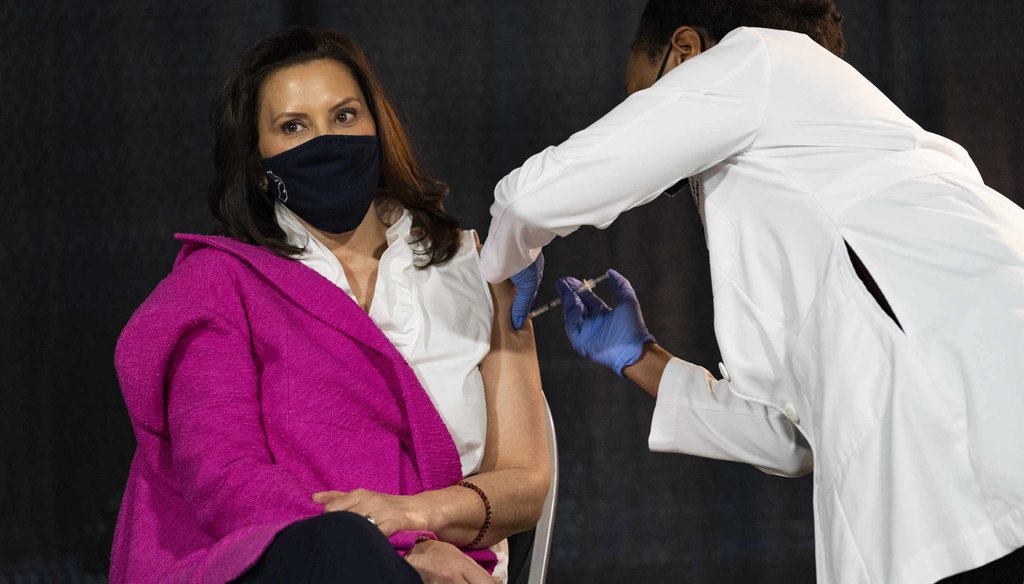Stand up for the facts!
Our only agenda is to publish the truth so you can be an informed participant in democracy.
We need your help.
I would like to contribute

Michigan Gov. Gretchen Whitmer gets her first COVID-19 vaccine dose Apr. 6, 2021, at Ford Field in Detroit, administered by Michigan Chief Medical Executive Dr. Joneigh S. Khaldun. (Mandi Wright, Detroit Free Press)
If Your Time is short
-
Michigan House Republicans evaluating Gov. Whitmer’s pandemic response on a "report card" gave her a failing grade.
-
Some of their claims are supported by the available data, and others are subjective or misleading.
A viral Facebook post from Republican legislators in Michigan criticizes Gov. Gretchen Whitmer’s response to the coronavirus pandemic amid the latest COVID-19 surge in the state.
Since the beginning of the pandemic, Republicans have characterized Whitmer’s approach as draconian, and now they claim that her response "has failed Michigan."
In a "COVID-19 response report card," the state House Republicans tick off various metrics and give Whitmer a failing grade on the state’s economic and health outcomes.
Whitmer spokesman Bobby Leddy said the post contains inaccurate information. "It’s unfortunate that Michigan Republicans continue to amplify false information at a time when we need to work together to get things done," Leddy wrote in an email to PolitiFact Michigan.
We took a look at the claims Republicans made to arrive at their grade on Whitmer and found that some are supported by the available data, while others are subjective or misleading.
"Top 10 Most Executive Orders in the Country"
This is true. The Council of State Governments has tracked executive orders issued in each state during the pandemic, from orders related to the allocation of protective equipment to rolling out vaccines. According to the tracker, the Whitmer administration has issued 175 executive orders. That’s second only to Colorado, where Democratic Gov. Jared Polis issued 356 executive orders.
Gideon D’Assandro, a spokesperson for state House Speaker Jason Wentworth, pointed to the high number of executive orders issued as "a sign of the governor going it alone and trying to manage this crisis all on her own."
Leddy blame Republican lawmakers for the breakdown in the relationship between the executive and legislative branches. "Rather than working with us to protect Michiganders, Republican lawmakers actively denied science, turned down federal aid, and refused to ask residents to wear masks — putting Michiganders’ lives at much greater risk."
"Top 10 Most Days Shut Down"
This is hard to pin down. The patchwork of restrictions and guidance in place in each state makes comparisons difficult.
Whitmer issued a stay-at-home order at the start of the pandemic and lifted it at the beginning of the summer. She reimposed restrictions in the fall when COVID-19 case and death rates reached a new peak, and then gradually rescinded restrictions by winter. Most businesses have been able to operate in some capacity for the majority of the past year.
D’Assandro cited restrictions on in-person office work, which are still in place and which the administration is contemplating extending. Many states have lifted those restrictions, while others strongly encourage remote work, and many employers and employees have opted to continue work-from-home arrangements.
D’Assandro also pointed to businesses that remain closed, such as water parks, nightclubs and indoor playgrounds.
There are indications that Michigan has had tighter restrictions than other states. An analysis from WalletHub, a personal finance website, looked at mask requirements, limits on gatherings, restaurant reopenings and other policies and found that Michigan has had more extensive social-distancing measures in place than most states.
There’s also evidence that the restrictions worked. An estimate from University of Michigan researchers finds that the "Pause to Save Lives" in mid-November may have cut coronavirus cases in Michigan by more than 109,000. And a Detroit Free Press analysis found that Michigan’s orders during this time helped drive down cases compared with neighboring states.
"Top 10 Most Businesses Closed"
Many Michigan businesses have struggled, while new ones seem to be emerging out of the pandemic.
D’Assandro pointed to data from the Opportunity Insights Economic Tracker, which looks at transaction data to determine whether businesses are still operating. The tracker shows that as of March 22, the number of small businesses in Michigan decreased by 42.5% since January 2020. Only Washington, D.C., recorded a greater decline.
"This does not mean that they have necessarily permanently closed, though — that’s very hard to track in real time," Brad Hershbein, a senior economist at the Kalamazoo-based W.E. Upjohn Institute for Employment Research, wrote in an email to PolitiFact Michigan.
Meanwhile, Michigan is among the top states for increases in applications for new businesses since the pandemic started, according to data compiled by the Census Bureau. Applications were up 56% in February 2021 compared with February 2020.
Economists continue to debate whether business closures are driven by government-issued restrictions or by consumers choosing to stay home. There is evidence that suggests the latter has had a greater impact.
"Most dangerous state to be elderly or live in a nursing home"
Available evidence does not support the claim that Michigan was the "most dangerous" state to be elderly or live in a nursing home.
People 65 and older make up 17.7% of Michigan’s population, and accounted for 83% of Michigan COVID-19 deaths, according to provisional data from the CDC.
But older adults have made up a disproportionate share of COVID-19 deaths everywhere, and Michigan’s 83% share ranks 29th among U.S. states.
While older adults in Michigan reported challenges in getting shots during the state’s initial vaccination rollout, nearly 70% of Michiganders 65 and older have received at least one dose. That’s slightly behind the national rate of 77%, according to CDC data.
As for the spread of COVID-19 in nursing homes, it’s difficult to get a clear answer on the impact of Whitmer’s nursing home policies. But case levels and the death toll at Michigan’s nursing homes have not been among the highest in the nation.
Because states report nursing home data differently and the federal government didn’t begin collecting information about nursing home deaths until June, it’s difficult to compare states. But federal data analyzed by the AARP Public Policy Institute provides some indication of how Michigan’s nursing home residents have fared.
The analysis shows that Michigan is not among the states with the highest nursing home COVID-19 death rates over the past year. Its highest ranking, in January 2021, was 16th in the country, at 2.12 deaths per 100 residents. In August and September, Michigan ranked 43rd. The analysis also shows Michigan’s per capita case rate among nursing home residents hasn’t ranked at the top among states, though there has been a surge in nursing home cases more recently.
Whitmer has faced criticism from Republicans for her decision to allow recovering COVID-19 patients to return to nursing homes with non-infected residents. But health researchers say that policy likely didn’t contribute much to the death toll in nursing homes, and they point to other factors, including high infection rates in surrounding communities and among staff.
"Data benchmarks provided: 0"
Republican lawmakers have criticized Whitmer for not tying decisions on reopening sectors of the economy to specific COVID-19 metrics, as many other states did. A bill before the Legislature would tie health orders to specific COVID-19 trends.
Whitmer has argued that it is difficult to mitigate the spread of COVID-19 based on metrics alone. In March, she vetoed a bill passed by the Legislature limiting the authority of the state health department and laying out specific case criteria for local health officials to follow in deciding whether to ban in-person classes or cancel sporting events.
"Fidelity to a specific number and percentage is problematic," Whitmer said at a January news conference, noting that her decisions depend on such factors as whether outbreaks involve a more contagious variant or a single employer.
"Top 10 in highest COVID death rate"
For this measure, D’Assandro pointed to COVID-19-related deaths as a percentage of COVID-19 cases. Michigan’s fatality rate is the eighth highest in the country for confirmed and probable COVID-19 deaths as a share of cases.
Dawn Misra, a professor of epidemiology and biostatistics at Michigan State University, told PolitiFact Michigan that the fatality rate "has little to do with the rate of disease in the population."
The fatality ratio indicates the severity of the illness, Misra explained, and it can be inaccurate if states aren’t doing enough testing.
She recommended looking instead at the number of COVID-19 deaths for every 100,000 residents.
Here, Michigan ranked 20th among U.S. states, with 173 deaths per 100,000 residents as of April 7, according to the CDC data.
Our Sources
Detroit Free Press, Whitmer signs COVID-19 relief bills, but vetoes more than $1 billion in GOP-backed deals, 3/9/21
Crain’s Detroit Business, Nursing home COVID-19 cases, deaths up in Michigan, despite vaccine program, 4/8/21
CDC, COVID-19 Nursing Data, accessed 4/9/21
Detroit Free Press, Michigan Senate GOP bill, backed by restaurant group, would mean no indoor dining now, 4/8/21
CDC, Demographic Trends of People Receiving COVID-19 Vaccinations in the United States, accessed 4/9/21
Dawn Misra, Department Chair and Professor of Epidemiology and Biostatistics, Michigan State University, email, 4/9/21
Our World in Data, Mortality Risk of COVID-19, accessed 4/9/21
World Health Organization, Estimating mortality from COVID-19, 8/4/20
MLive, COVID-19 numbers alone shouldn’t trigger Michigan reopenings, Whitmer says. Critics want a plan., 1/30/21
Detroit Free Press, Whitmer: GOP threat to withhold school COVID-19 funds is 'cruel and reckless', 1/28/21
Detroit Free Press, What we know about the impact of Whitmer’s nursing home policies, 3/12/21
CDC, COVID Data Tracker, updated Apr. 6 at 1:34 p.m.
The Detroit Free Press, Vaccinating Michigan: Tracking the progress of the state's COVID-19 vaccine rollout, accessed 4/8/21
Bridge Michigan, Older adults in Michigan frustrated in efforts to get COVID vaccine, 1/12/21
JUSTIA, COVID-19 Restrictions: 50-State Resources, accessed 4/8/21
Michigan Department of Health and Human Services, March 19 - Gatherings and Face Mask Order
MI Safe Start Restrictions, accessed 4/8/21
The Detroit Free Press, Michigan could extend in-person office work restrictions to October, 3/15/21
Michigan House Republicans, Facebook post, 4/7/21
The Detroit Free Press, Michigan's COVID-19 surge driven by 'perfect storm' of variant cases, reopening, 4/6/21
The Council of State Governments, Executive Orders, accessed 4/8/21
The Detroit Free Press, Donald Trump says Michigan is 'like a prison'. It's not., 10/22/20
The Detroit Free Press, Data shows Whitmer's COVID-19 restrictions worked: How Michigan compared to nearby states, 2/5/21
Opportunity Insights Economic Tracker, accessed 4/8/21
Brad Hershbe, Senior Economist and Communications Advisor, W.E. Upjohn Institute for Employment Research, email, 4/8/21
Business Applications, Business Formation Statistics, U.S. Census, accessed 4/8/21
National Bureau of Economic Research, Mandated and Voluntary Social Distancing During the COVID-19 Epidemic: A Review, November 2020
AARP Public Policy Institute, AARP Nursing Home COVID-19 Dashboard, accessed 4/8/21
Amanda Davis, AARP, Senior Advisor - Advocacy, External Relations, email, 4/8/21
Kaiser Family Foundation, Population Distribution by Age, accessed 4/8/21
CDC, Provisional COVID-19 Death Counts by Sex, Age, and State, accessed 4/8/21
Blair Hess, The Council of State Governments, Assistant Director of Communications, email, 4/8/21
University of Michigan, Strict public health measures during holidays likely saved lives in Michigan, U-M researchers say, 1/28/21
University of Michigan, Model estimates that increased social distancing following the Pause to Save Lives prevented over 109,000 cases, accessed 4/8/21
WalletHub, States with the Fewest Coronavirus Restrictions, 4/6/21
Gideon D’Assandro, spokesperson Michigan House Speaker Jason Wentworht, email, 4/8/21 and 4/9/21
















































